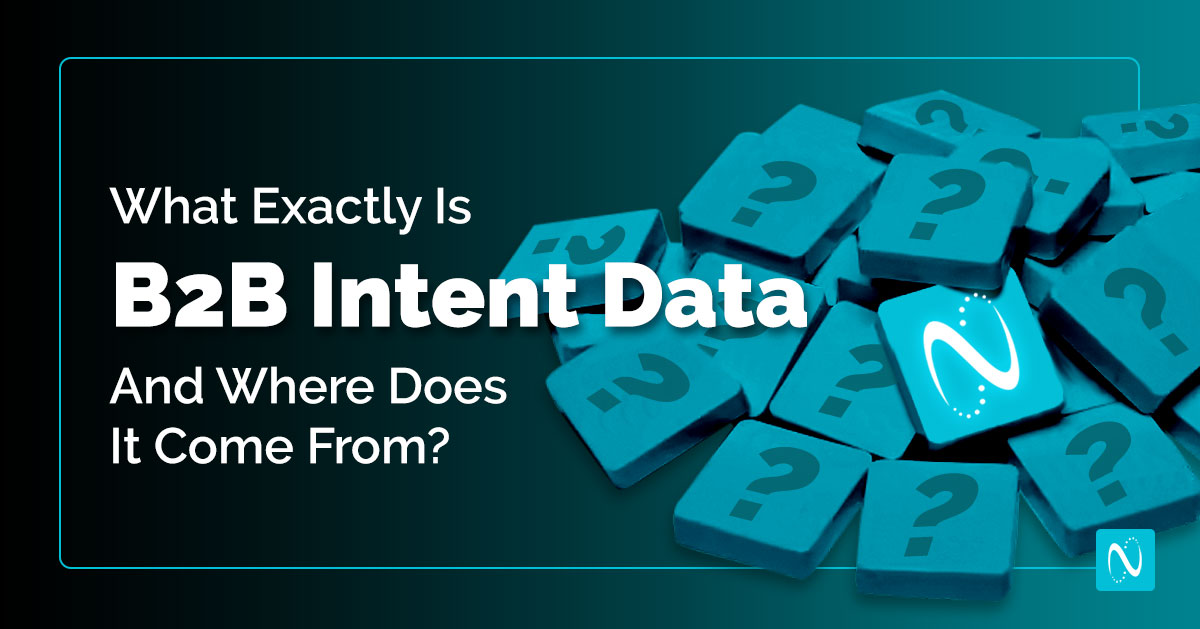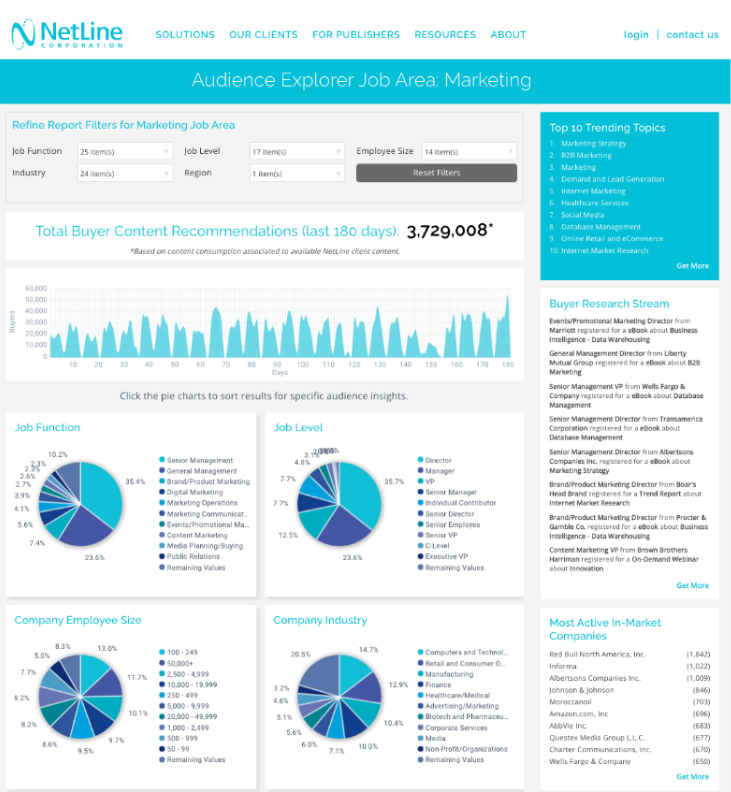If you’re a B2B marketer, chances are you’ve heard of “intent data” but may not understand what it’s all about or how to use it effectively.
Indeed, if you’ve already been scoring prospects that visit your site, or have created lists of accounts that meet your ideal customer profile, until now it’s quite reasonable to assume that you’ve already been trying to identify those who want to buy from those who don’t.
In this post, we’ll provide a brief overview about intent data; specifically, what is the definition of intent data, why it has become such a hot topic, the types and sources of intent data, and how B2B marketers and salespeople are putting it to use.
What is the Definition of B2B Buyer Intent Data?
According to Gartner, “intent data is information that indicates prospects’ level of interest in a particular product or service online.”
This differentiates intent data from the other types of data that marketers collect and use when trying to reach and engage those who fit their ideal customer profile, such as job function or firmographic data including company size, industry or revenue.
These data points might illustrate the potential for a prospect or company to become a customer and whether they fall into a target audience—but they do nothing to show whether they are considering making a buying decision or when exactly they might begin the buying process.
By contrast, B2B buyer intent data tells marketers and sales reps which accounts are showing intent, which prospective buyers are actively researching online, and which pain points they are looking to solve based on their content consumption. These data insights revealing purchase intent can help sales teams and marketers to reach out at exactly the right time with relevant content meeting their needs.
Why Has Buyer Intent Data Become Such a Hot Topic for B2B Marketers?
The technology and data sources that marketing and sales teams have access to today would have been unthinkable just a decade ago.
In the past, it would have been impossible for a single marketer or sales rep to identify companies and create lists of thousands of potential customers from scratch. Likewise, it would have been impossible to create marketing campaigns that can reach these potential buyers in the space of a few hours.
However, while this has made today’s B2B marketers and sales professionals potentially far more effective, the overuse of data and technology for marketing and sales campaigns has created a huge amount of noise—both for buyers who have their inboxes swamped by irrelevant cold outreach, and the marketers and sales reps who are trying through data to identify prospects who are active buyers and which target accounts are actually in-market and have purchase intent.
With marketers and salespeople struggling to cut through the noise, identify in-market accounts and then successfully engage the right prospects, interest in buyer intent solutions has ballooned.
As highlighted in a previous NetLine post on buyer intent, data from Ahrefs shows that in the past five years, the number of web pages focused on intent data rose by 2,739.1%.
In short, B2B intent data provides the potential for sales and marketing teams to concentrate their efforts on those who are most likely to buy.
Furthermore, for those accounts and buyers who aren’t yet close to making a purchase decision—or might not have even started a buying cycle—marketers can ensure they see informational and top-of-funnel content, rather than sending them to sales when it is far too early. This leads to a better overall buying experience.
What are the Different Types and Sources of Buyer Intent Data?
The volume of data generated worldwide continues to grow massively. In fact, IDC estimates that by 2025, the size of the global “datasphere” will reach 175 exabytes—equivalent to 175 billion terabytes. To put this in perspective, IDC calculates that to download all this data using the average domestic connection speed in the United States of 25 Mb/s, it would take approximately 1.8 billion years!
Given that marketers are responsible for generating much of this raw data, it follows that marketers can potentially mine it for insights. For this, they would need to sift through it all, surface relevant information and separate out intent data from the rest.
But even though B2B marketers want to take advantage of this intent data, actually finding, structuring and using it is a huge challenge. To address this need, there are now many intent data providers that can analyze your company’s own data in addition to sourcing other intent signals from digital engagement across the web—just as NetLine uses the data from across its network to power products such as Audience Explorer.
| Image caption: A screenshot of NetLine Audience Explorer showing content consumption, buyer research and the most active in-market companies with B2B buyers. |
Intent data sources can be broken down into two main categories:
- Your internal data—everything from the clicks, behavioral signals and engagement collected by your marketing automation platform, to customer data and sales outreach data in your CRM.
- External data—this can include IP addresses used by companies from across the web, visits to vendor review websites, and the content consumed by users associated with companies (via IP address, cookies or other means). This information is most often aggregated at the account-level with the overall total engagement being assessed for intent signals.
As such, listing all the types of intent data would be nearly impossible, because any relevant data has the potential to identify intent. Just a few examples types of buyer intent data collected can include:
- Themes being researched based on content engagement data from media publishers;
- Topic searches and specific keywords that align with intent signals;
- Internal intent data about known contacts, qualified leads and lead generation efforts;
- Third-party data in your own systems added by data enrichment tools;
- The specific articles read by potential prospects in the buyer’s journey on your own website and properties—with bottom-of-funnel activity (such as reading pricing pages or downloading case studies) being used to identify readiness-to-buy;
- The accounts and target audiences that have engaged with your ad campaigns and account-based marketing programs;
- Sales data and opportunity data;
- Customer data;
- …and much, much more.
However, what you might recognize from the above list is that for much buyer intent data, the intent is assumed or inferred indirectly. This can potentially lead to accounts and buyers being flagged as “in-market” when actually they aren’t. Examples of such false intent might include:
- Lots of topic research on media publisher sites and web searches—when actually the person was an intern doing market research.
- Multiple visits to pricing pages or review sites—when that person was doing competitive research.
- A sudden jump in engagement with bottom-of-funnel and sales content—when that person was preparing for a job interview with your company.
For this reason, having a buyer tell you explicitly whether they are in-market or not will always be more accurate and powerful than simply inferring intent based on other information collected. That’s why NetLine adds questions about intent to the forms used across its content syndication network. The answers to these questions help to power its Intent Discovery capabilities.
What is the Difference Between First-Party and Third-Party Intent Data?
First-party intent data is the data that you or your company collect directly. This will include data from your own digital channels and systems, such as website visits and email engagement.
This type of data typically covers a shorter timeline than third-party intent data and is more closely associated with activities taking place on your web properties or in your CRM—but it also includes proprietary, unique data that you might collect from properties that you do not own, such as on a download form for syndicated content or registrations for a partner webinar hosted by another company.
Third-party intent data refers to the data that isn’t directly sourced by you or your company. This will be data sourced from external sources, such as IP addresses associated with companies browsing the web or content being read on media publisher websites.
This type of data typically covers a longer timeline and from buyers that have not yet engaged directly with your own web properties. It can be used to detect intent signals from a wider range of sources, with vendors often aggregating behavior into a single and easy-to-use intent score, or a summary list of topics and themes based on their browsing behavior.
Buyer-Level Intent Data Seems Like a Powerful Tool. So, How Are B2B Sales and Marketing Teams Putting Buyer Intent Data to Use?
We will cover exactly how B2B marketers and salespeople are putting intent data to use later in this series—and how you, your marketing team and your sales team can use intent data to accelerate the buyer journey and generate revenue.
For now, we’ll direct you back to our initial buyer-level intent blog post:
- Personalize dialogue in sales and marketing outreach;
- Tailor campaign and content messaging with both paid and inbound marketing efforts;
- Identify likely-to-buy accounts;
- Inform and augment content-centric lead generation campaign targets; and
- Possibly most important of all, focus on the “who” within key accounts to narrow down efforts onto the actual person and buyer showing intent.
Hope you’re eager to learn more about intent data and each of its iterations. We’ll certainly have quite a bit to share on the subject moving forward.


